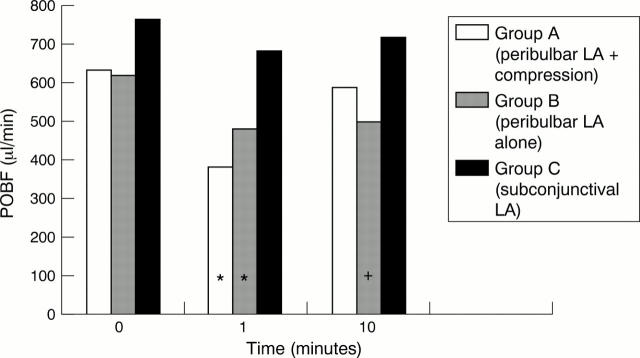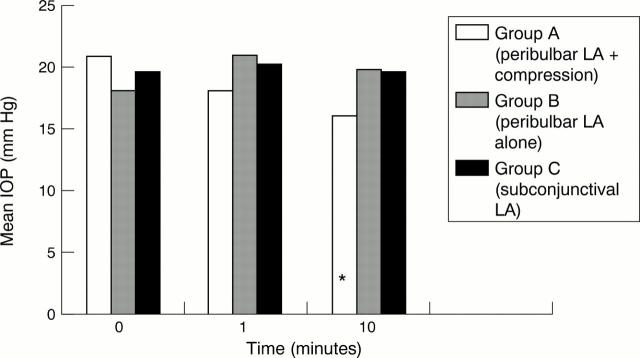Abstract
AIM—To compare pulsatile ocular blood flow (POBF) and intraocular pressure (IOP) between eyes of patients receiving either peribulbar (with and without balloon compression) or subconjunctival local anaesthesia (LA). METHODS—30 eyes of 30 patients undergoing cataract surgery by phacoemulsification were investigated in a study of parallel group design. Ten patients had peribulbar LA and 10 minutes compression with a Honan's balloon (group A). A further 10 patients who received peribulbar LA alone (group B) acted as controls for the effects of balloon compression. Ten other patients were given subconjunctival LA (group C). POBF and IOP were measured using a modified Langham pneumatonometer. Three measurements were made in each eye, the first recording immediately before LA, the second 1 minute after, and the third 10 minutes after LA. RESULTS—No significant change in POBF or IOP was recorded in eyes receiving subconjunctival LA. In the peribulbar groups (A and B), there was a drop in median POBF of 252 and 138 µl/min respectively 1 minute after LA, which was statistically significant in both groups (p<0.01). By 10 minutes, POBF tended to return to baseline levels, but remained significantly reduced in group B (p<0.05). In addition, there was a significant (p<0.05) reduction in IOP (mean drop of 4.82 mm Hg) in group A following peribulbar LA with balloon compression. CONCLUSIONS—POBF was significantly reduced after peribulbar LA but was unchanged after subconjunctival LA. Balloon compression reduced IOP and improved POBF following peribulbar LA. The findings may have clinical implications in patients with compromised ocular circulation or significant glaucomatous optic neuropathy.
Full Text
The Full Text of this article is available as a PDF (116.4 KB).
Figure 1 .
Median pulsatile ocular blood flow (POBF) before and after local anaesthesia. *Statistically significant drop (p<0.01) in POBF. +Statistically significant drop (p<0.05) in POBF.
Figure 2 .
Mean IOP (mm Hg) before and after local anaesthesia. *Statistically significant drop in IOP after 10 minutes of compression (p<0.05).
Selected References
These references are in PubMed. This may not be the complete list of references from this article.
- Bosem M. E., Lusky M., Weinreb R. N. Short-term effects of levobunolol on ocular pulsatile flow. Am J Ophthalmol. 1992 Sep 15;114(3):280–286. doi: 10.1016/s0002-9394(14)71791-x. [DOI] [PubMed] [Google Scholar]
- Bowman R., Liu C., Sarkies N. Intraocular pressure changes after peribulbar injections with and without ocular compression. Br J Ophthalmol. 1996 May;80(5):394–397. doi: 10.1136/bjo.80.5.394. [DOI] [PMC free article] [PubMed] [Google Scholar]
- Findl O., Dallinger S., Menapace R., Rainer G., Georgopoulos M., Kiss B., Schmetterer L. Effects of peribulbar anesthesia on ocular blood flow in patients undergoing cataract surgery. Am J Ophthalmol. 1999 Jun;127(6):645–649. doi: 10.1016/s0002-9394(99)00066-5. [DOI] [PubMed] [Google Scholar]
- Hessemer V. Anästhesie-Effekte auf den okulären Kreislauf. Synopsis einer Studie. Fortschr Ophthalmol. 1991;88(5):577–587. [PubMed] [Google Scholar]
- Hitchings R. The ocular pulse. Br J Ophthalmol. 1991 Feb;75(2):65–65. doi: 10.1136/bjo.75.2.65. [DOI] [PMC free article] [PubMed] [Google Scholar]
- Kagemann L., Harris A., Chung H. S., Evans D., Buck S., Martin B. Heidelberg retinal flowmetry: factors affecting blood flow measurement. Br J Ophthalmol. 1998 Feb;82(2):131–136. doi: 10.1136/bjo.82.2.131. [DOI] [PMC free article] [PubMed] [Google Scholar]
- Kiel J. W., Lovell M. O. Adrenergic modulation of choroidal blood flow in the rabbit. Invest Ophthalmol Vis Sci. 1996 Mar;37(4):673–679. [PubMed] [Google Scholar]
- Langham M. E., Farrell R. A., O'Brien V., Silver D. M., Schilder P. Blood flow in the human eye. Acta Ophthalmol Suppl. 1989;191:9–13. doi: 10.1111/j.1755-3768.1989.tb07080.x. [DOI] [PubMed] [Google Scholar]
- Meyer D., Hamilton R. C., Loken R. G., Gimbel H. V. Effect of combined peribulbar and retrobulbar injection of large volumes of anesthetic agents on the intraocular pressure. Can J Ophthalmol. 1992 Aug;27(5):230–232. [PubMed] [Google Scholar]
- Meyer P., Flammer J., Lüscher T. F. Local anesthetic drugs reduce endothelium-dependent relaxations of porcine ciliary arteries. Invest Ophthalmol Vis Sci. 1993 Aug;34(9):2730–2736. [PubMed] [Google Scholar]
- O'Donoghue E., Batterbury M., Lavy T. Effect on intraocular pressure of local anaesthesia in eyes undergoing intraocular surgery. Br J Ophthalmol. 1994 Aug;78(8):605–607. doi: 10.1136/bjo.78.8.605. [DOI] [PMC free article] [PubMed] [Google Scholar]
- Trew D. R., Smith S. E. Postural studies in pulsatile ocular blood flow: I. Ocular hypertension and normotension. Br J Ophthalmol. 1991 Feb;75(2):66–70. doi: 10.1136/bjo.75.2.66. [DOI] [PMC free article] [PubMed] [Google Scholar]
- Trew D. R., Smith S. E. Postural studies in pulsatile ocular blood flow: II. Chronic open angle glaucoma. Br J Ophthalmol. 1991 Feb;75(2):71–75. doi: 10.1136/bjo.75.2.71. [DOI] [PMC free article] [PubMed] [Google Scholar]
- Williamson T. H. What is the use of ocular blood flow measurement? Br J Ophthalmol. 1994 May;78(5):326–326. doi: 10.1136/bjo.78.5.326. [DOI] [PMC free article] [PubMed] [Google Scholar]




